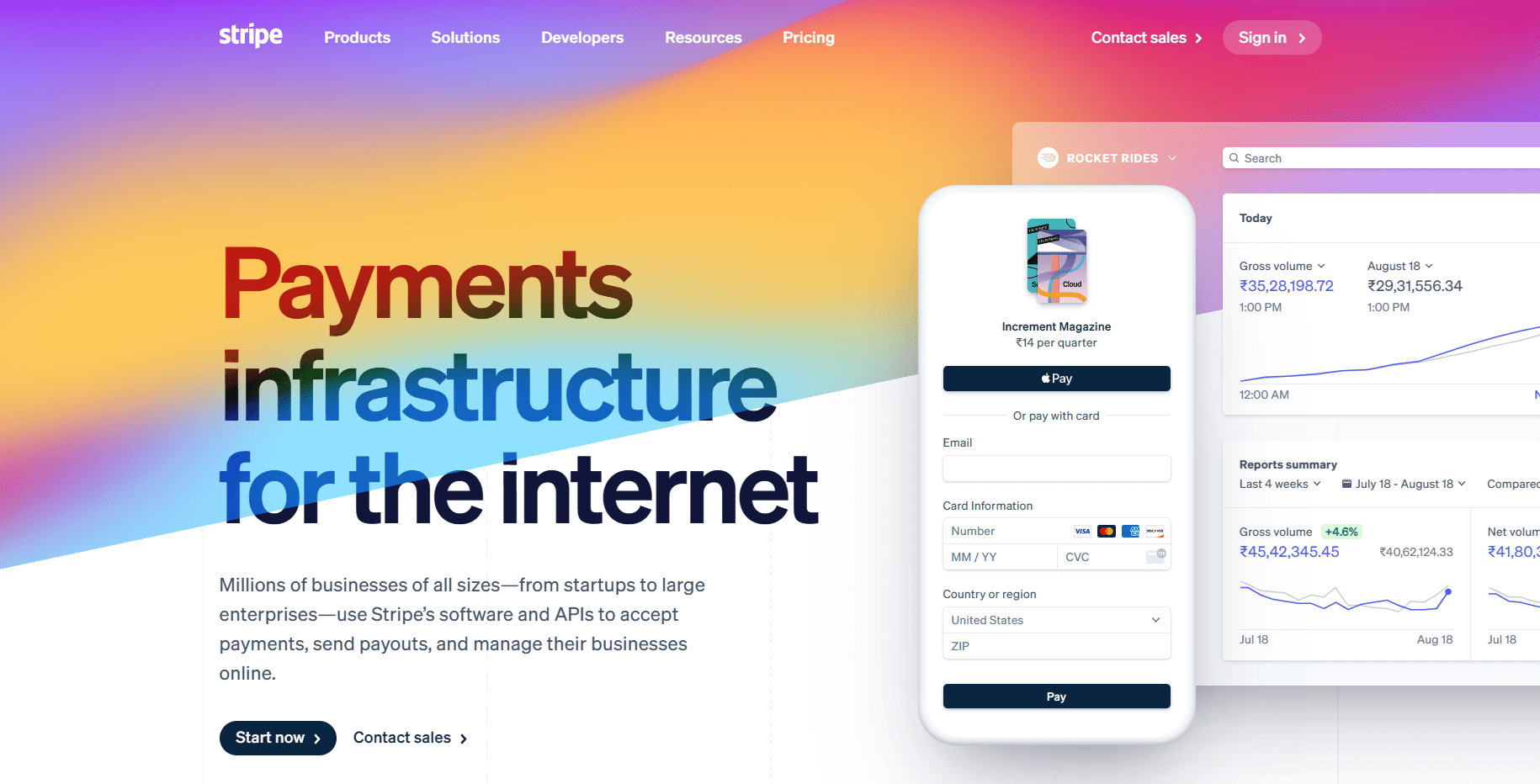When it comes to accepting payments online, choosing the right platform can make a big difference in how smoothly your business runs. ThriveCart and Stripe are two of the most talked-about options today, each offering its own strengths for entrepreneurs, course creators, and online sellers.
While Stripe powers the payment infrastructure for millions of businesses worldwide, ThriveCart focuses on giving you an all-in-one solution to sell products, manage affiliates, and boost conversions. Both platforms promise efficiency and reliability, but they take very different approaches to getting there.
In this detailed ThriveCart vs Stripe comparison, we’ll break down how each performs in real-world use, helping you decide which one fits your business goals and growth strategy best.
ThriveCart Overview

Back in 2016, Josh Bartlett introduced ThriveCart, a powerful shopping cart platform built to help entrepreneurs and digital creators sell their products with ease. What began as a smart idea has grown into one of the most popular tools in the online business world, trusted by more than 100,000 users worldwide.
ThriveCart continues to evolve, adding new features that make selling, managing affiliates, and building high-converting checkout pages simpler than ever. Its true strength lies in how smoothly it integrates with other essential tools, whether your email marketing software, course platform, or payment processor, creating a complete ecosystem that works effortlessly together.
Despite its simplicity, ThriveCart is remarkably powerful, giving business owners the flexibility and control they need to scale.
Read ThriveCart Review for more information.
Stripe Overview

Stripe, on the other hand, is a global leader in online payment processing, trusted by millions of businesses for its reliability, security, and speed. It powers transactions for many of the world’s most popular websites and remains the preferred choice for handling online payments with ease. Known for its seamless integrations, transparent pricing, and quick affiliate payouts, Stripe has built a reputation as one of the most dependable platforms in the industry.
However, its focus is primarily on payment infrastructure rather than sales optimization. It doesn’t provide tools for building checkout pages, managing affiliates, or designing sales funnels, features that ThriveCart is specifically built to handle. While Stripe dominates the technical side of payment processing, it lacks the all-in-one marketing and selling capabilities that make ThriveCart so appealing to digital entrepreneurs and course creators.
ThriveCart Vs Stripe: Main Difference
ThriveCart and Stripe serve two very different yet complementary purposes in the online business world. ThriveCart is a complete shopping cart platform that helps you build sleek, conversion-focused checkout pages and sales funnels designed to boost revenue.
Stripe, meanwhile, specializes in handling the technical side of payment processing, ensuring every transaction is fast, secure, and reliable. ThriveCart gives you the creative tools to shape the customer experience, while Stripe takes care of the behind-the-scenes financial operations that keep your business running smoothly.
When used together, they create a seamless workflow that combines sales design with dependable payment infrastructure. This blend of customization and security makes the ThriveCart vs Stripe combination an ideal setup for entrepreneurs who want performance, flexibility, and long-term growth.
ThriveCart Vs Stripe: Features
ThriveCart clearly stands out from its competitors thanks to its powerful features and user-friendly design. It simplifies online selling while giving entrepreneurs complete control over how their checkout pages and sales funnels look and perform. When integrated with Stripe, the setup becomes even stronger, combining ThriveCart’s conversion-focused tools with Stripe’s secure and reliable payment processing.
Stripe is already one of the most trusted names in e-commerce, but ThriveCart enhances its potential by offering flexibility, customization, and advanced marketing features that help boost revenue. The ability to design fully personalized order forms has made a noticeable difference in conversion rates, turning casual visitors into loyal customers.
With its seamless performance and practical tools, ThriveCart remains one of the best and most dependable shopping cart platforms for digital businesses of all sizes.
ThriveCart Vs Stripe: Pricing
ThriveCart offers tremendous value for entrepreneurs looking to simplify and scale their online sales. ThriveCart Ultimate includes three valuable components that give you a complete business toolkit. The main ThriveCart plan costs $495 one-time and provides lifetime access to powerful checkout and sales features.
The Pro+ upgrade, priced at $295 per year, adds advanced tools such as subscription management and automatic sales tax calculation. The Learn+ upgrade, available for a one-time fee of $195, unlocks ThriveCart’s course and membership platform. Together, they create a long-term solution for building, managing, and scaling your online business with ease.
When you consider that similar platforms often charge around $100 per month, ThriveCart’s one-time payment quickly proves to be a smart and cost-effective investment. It gives you complete creative freedom without the burden of ongoing subscription fees. Check out my complete guide on How Much ThriveCart Costs Here.
Stripe, on the other hand, takes a different approach. It charges a standard processing fee, plus a small fee per transaction. Stripe charges 2.9% plus 30 cents per successful online transaction for domestic cards. International payments incur a 1.5% fee, and manually entered cards incur a 0.5% fee. For in-person payments through Stripe Terminal, the fee drops to 2.7% plus 5 cents.
The pricing is fair considering the reliability and security it offers, yet over time, these small fees can accumulate, especially for businesses handling a large number of sales. While Stripe is exceptional for processing payments, it doesn’t include tools for customizing checkout or building sales pages that encourage higher conversions.
At first, using Stripe alone might seem like a cheaper option, but without the ability to optimize your checkout process, you could miss out on substantial revenue. Even a slight boost in conversions can easily justify the cost of ThriveCart over the long run. For business owners who want complete control, scalability, and a more polished sales experience, ThriveCart remains the more practical and profitable choice.
Click Here to Read the ThriveCart Payment Gateways Guide.
Conclusion
ThriveCart has proven itself to be one of the most powerful and versatile tools for online entrepreneurs. It offers a smooth learning experience, lifetime access, and an impressive range of features that simplify selling digital products, memberships, and courses.
With seamless integrations for major payment processors such as Stripe and PayPal, it bridges the gap between creative flexibility and secure payment handling. Stripe remains an industry leader for reliable transactions, but ThriveCart takes things further by allowing business owners to design checkout pages and sales funnels that truly convert.
When you compare ThriveCart vs Stripe, the difference is easy to see. Stripe excels at fast, secure, and dependable payment processing, while ThriveCart elevates the entire sales journey with customizable checkout pages and built-in conversion tools.
Stripe handles the technical side of transactions flawlessly, but ThriveCart gives business owners the creative control needed to boost engagement and sales performance. For entrepreneurs aiming to increase revenue and simplify operations, ThriveCart stands out as the smarter, more complete solution that turns payment processing into a powerful selling system.
FAQs
How much does ThriveCart cost each month?
ThriveCart doesn’t follow the typical monthly subscription model. Instead, it offers a one-time payment for lifetime access, which makes it a cost-effective choice for long-term use. The standard plan is available for a single payment of $495, while the optional ThriveCart Pro+ upgrade adds extra advanced features for an additional $295 per year. This structure eliminates recurring costs, allowing entrepreneurs to focus on growing their businesses without worrying about ongoing fees.
What makes ThriveCart different from Stripe?
While both ThriveCart and Stripe play key roles in online sales, they serve very different purposes. Stripe is primarily a payment processor that handles transactions quickly and securely. ThriveCart, on the other hand, is a complete checkout and sales-optimization platform designed to increase conversions through customizable checkout pages, upselling, and affiliate management. In simple terms, Stripe processes payments, whereas ThriveCart helps businesses sell more effectively.
Can ThriveCart integrate with Stripe?
Yes, ThriveCart works perfectly with Stripe, and the setup is quick and effortless. Inside your ThriveCart dashboard, you simply select the option to connect to Stripe, authorize access, and your accounts link instantly. Once connected, ThriveCart uses Stripe to securely process payments, enabling you to create a smooth checkout experience for customers. This seamless integration helps businesses accept payments efficiently while keeping all transactions organized in one place.
Does ThriveCart charge a percentage on each sale?
ThriveCart does not take any percentage or commission from your sales. Once you purchase the platform, it’s yours to use without hidden fees or recurring charges. The only costs you’ll encounter are the standard transaction fees from your connected payment processor, such as Stripe or PayPal. This one-time purchase model gives you unlimited earning potential while keeping your long-term expenses predictable and minimal.
What are the drawbacks of using Stripe?
Although Stripe is a reliable and widely used payment processor, it isn’t the perfect fit for everyone. Some users find its transaction fees slightly higher than those of other options, and setting it up can require a bit of technical knowledge. Additionally, occasional payout delays and limited customization for checkout experiences can be frustrating for merchants seeking more flexibility and immediate access to funds.
Which is better, Stripe or PayPal?
Both Stripe and PayPal are trusted payment solutions, but Stripe often stands out for businesses that manage a large number of online or in-person transactions. It supports multiple payment methods, offers flexible integrations, and gives merchants greater control over the checkout experience. PayPal, while convenient and widely recognized, can be limiting for advanced customization. For scalability, automation, and global reach, Stripe is generally the stronger, more adaptable option for growing businesses.
Further Read:

